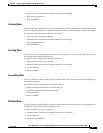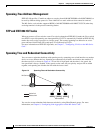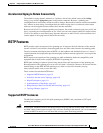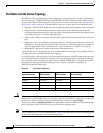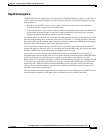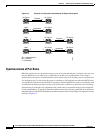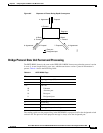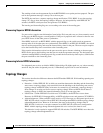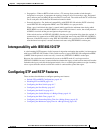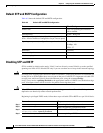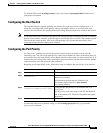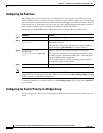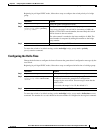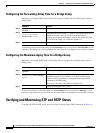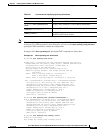
6-15
Cisco ONS 15310-CL and Cisco ONS 15310-MA Ethernet Card Software Feature and Configuration Guide R8.5
78-18133-01
Chapter 6 Configuring STP and RSTP on the ML-Series Card
Interoperability with IEEE 802.1D STP
• Propagation—When an RSTP switch receives a TC message from another switch through a
designated or root port, it propagates the topology change to all of its non-edge, edge, designated
ports, and root port (excluding the port on which it is received). The switch starts the TC-while timer
for all such ports and flushes the information learned on them.
• Protocol migration—For backward compatibility with IEEE 802.1D switches, RSTP selectively
sends IEEE 802.1D configuration BPDUs and TCN BPDUs on a per-port basis.
When a port is initialized, the timer is started (which specifies the minimum time during which
RSTP BPDUs are sent), and RSTP BPDUs are sent. While this timer is active, the switch processes
all BPDUs received on that port and ignores the protocol type.
If the switch receives an IEEE 802.1D BPDU after the port’s migration-delay timer has expired, it
assumes that it is connected to an IEEE 802.1D switch and starts using only IEEE 802.1D BPDUs.
However, if the RSTP switch is using IEEE 802.1D BPDUs on a port and receives an RSTP BPDU
after the timer has expired, it restarts the timer and starts using RSTP BPDUs on that port.
Interoperability with IEEE 802.1D STP
A switch running RSTP supports a built-in protocol migration mechanism that enables it to interoperate
with legacy IEEE 802.1D switches. If this switch receives a legacy IEEE 802.1D configuration BPDU
(a BPDU with the protocol version set to 0), it sends only IEEE 802.1D BPDUs on that port.
However, the switch does not automatically revert to the RSTP mode if it no longer receives
IEEE 802.1D BPDUs because it cannot determine whether the legacy switch has been removed from the
link unless the legacy switch is the designated switch. Also, a switch might continue to assign a boundary
role to a port when the switch to which this switch is connected has joined the region.
Configuring STP and RSTP Features
These sections describe how to configure spanning-tree features:
• Default STP and RSTP Configuration, page 6-16
• Disabling STP and RSTP, page 6-16
• Configuring the Root Switch, page 6-17
• Configuring the Port Priority, page 6-17
• Configuring the Path Cost, page 6-18
• Configuring the Switch Priority of a Bridge Group, page 6-18
• Configuring the Hello Time, page 6-19
• Configuring the Forwarding-Delay Time for a Bridge Group, page 6-20
• Configuring the Maximum-Aging Time for a Bridge Group, page 6-20



